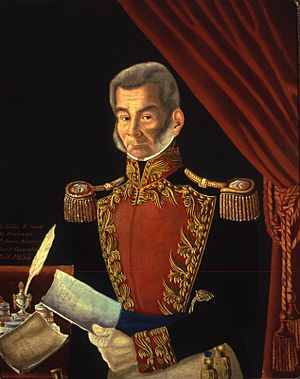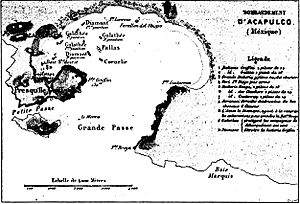Battle of Acapulco facts for kids
Quick facts for kids 1st Battle of Acapulco |
||||||||
|---|---|---|---|---|---|---|---|---|
| Part of the Second French intervention in Mexico | ||||||||
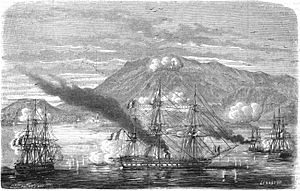 Entry of the French division in the Bay of Acapulco, January 10, 1863. |
||||||||
|
||||||||
| Belligerents | ||||||||
| Commanders and leaders | ||||||||
| Diego Álvarez Benítez Juan Álvarez Luis Ghilardi |
Captain Eugène Mathurin Marie Le Bris Durumain Rear Admiral Adolphe Charles Émile Bouët |
John Augustus Sutter, Jr. | ||||||
| Units involved | ||||||||
| Southern Army | French naval division of the Pacific ocean | Pacific Squadron | ||||||
| Strength | ||||||||
| ~dozen garrison | 4 men-o-wars 100 marines |
Warship Saranac | ||||||
| Casualties and losses | ||||||||
| 12–13 dead | possibly none | possibly none | ||||||
| Americans remained neutral. According to the accounts Don Juan Sutter raised the American flag onto a boat and sailed to the French flagship Pallas across the cannon fire. He convinced Admiral Bouet to stop the shelling of civilian houses. | ||||||||
The Battles of Acapulco were important fights during the Second French intervention in Mexico. Acapulco was a very important port city on the Pacific Ocean. Because of its location, the city was captured by different sides many times. During this war, Acapulco's population dropped from 6,000 people to just 2,000.
Contents
First Battle of Acapulco
In early 1863, Juan Álvarez and his group of Mexican fighters still controlled Guerrero and Acapulco. The French army had not yet reached these areas.
French Demands and Mexican Refusal
On January 8, 1863, a French warship called the Diamant arrived in Acapulco. Its captain, Le Bris, made several demands to General Diego Álvarez. He wanted to buy coal and water for his ship. He also demanded that General Álvarez apologize for anti-French statements. These statements were made by a Mexican officer named Luis Ghilardi. Ghilardi had caused a French warship to be turned away before. The French also wanted Ghilardi removed from his job. Finally, they demanded that all of Acapulco's fort defenses be taken down.
The next day, the Mexicans sent an apology. However, they refused the first two demands. Acapulco then began to get ready for a fight.
The Bombardment Begins
On January 10, at 8:45 AM, a French fleet arrived. It included the Diamant, Pallas, Bayonnaise, and Galathée. The French ships immediately started firing at Acapulco's forts. The Mexican forts fired back. After an hour of heavy shooting, the cannons at Fort Guerrero were destroyed. Ten minutes later, Fort Iturbide was silenced. By 10:00 AM, Fort Galeana also stopped firing.
Fort Álvarez kept fighting back against the French ships. However, the Mexican cannons could not shoot as far as the French ones. During the attack, some French shells hit the town itself. An American representative protested this, and the French stopped firing at civilian areas.
Aftermath of the First Battle
The next day, the French continued to attack Fort Álvarez. Luis Ghilardi and his men fought bravely from one of the forts. Some of their larger cannons caused serious damage to the French flagship Pallas. It was almost sunk during the fight.
The French fleet continued to bombard Acapulco for another day. On January 16, about 100 French sailors marched into the deserted city. They fired shots into the town for three days. Only a few Mexican soldiers were left, and some were killed. Finally, the French damaged some of the fort's cannons. They threw others into the sea. Then, they returned to their ships and left the bay. They sailed to Siguantanejo to check on the Pallas. They found it had been hit by 15 or 16 shells. The ship then went to Mazatlán for repairs.
Second Battle of Acapulco
| 2nd Battle of Acapulco | ||||||||
|---|---|---|---|---|---|---|---|---|
| Part of the Second French intervention in Mexico | ||||||||
|
||||||||
| Belligerents | ||||||||
| Commanders and leaders | ||||||||
| Rafael Solís | Adolphe Charles Émile Bouët | Charles Henry Bell | ||||||
| Units involved | ||||||||
| Southern Army | Algerian Riflemen Battalion, French naval division of the Pacific ocean | Pacific Squadron | ||||||
| Strength | ||||||||
| 581 men | 860 men 5 vessels |
Warship Saginaw | ||||||
| Casualties and losses | ||||||||
| 581 POWs | possibly none | possibly none | ||||||
| Americans remained neutral. US Navy only observed the blockade and defended its trade interests but also protected the city from looting during the interregnum. | ||||||||
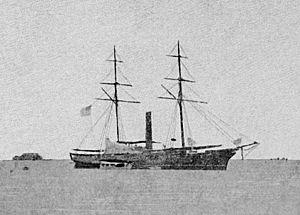
The second battle for Acapulco happened after a three-month blockade. The French navy had blocked the port since March 1864. On June 3, the city surrendered to the French. French troops entered the town without any fighting.
French Occupation and Republican Retreat
The French captured three small boats. They also ended the blockade, allowing American ships to enter the harbor. However, these ships could not unload passengers or goods. Admiral Bouët had sent for 474 Algerian Riflemen from Vera Cruz in May. These soldiers took control of the city on June 3–4.
The French then chased the Mexican Republican soldiers to Puebla Nuevo. There, they fought a smaller group of 200 soldiers. The French killed 50 of them and captured four cannons. The Algerian Battalion had four soldiers injured. They continued along the road to Los Cajones. However, the Mexican Liberals stopped them there, and the French lost their commander. The French soldiers went back to Acapulco. They made the forts stronger with more guns. They also assigned a warship to protect the port.
First Evacuation of Acapulco
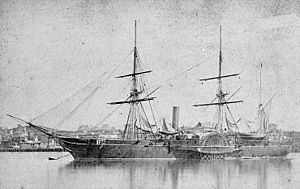
Acapulco was under siege from the start. This meant that no supplies could reach the 250 soldiers defending the city, and they faced starvation. In June 1864, General Juan Vicario tried to break the siege. He led 3,000 Mexican soldiers from Álvarez to the city. But they were badly defeated and gave up. Álvarez fired bullets into Acapulco to show his power.
The French Admiral ordered Acapulco to be evacuated. This order was to take effect on December 11, 1864. Three French ships were in port, ready to sail to Mazatlán. About 200 people who feared revenge from the Mexican forces wanted to leave. A group of foreign residents met with General Álvarez. He promised them that their lives and property would be safe. But many people did not trust the Mexican soldiers. This led to a large number of people leaving the city.
The American warship USS Saranac and the steamship Golden Age were in port to watch what happened. Captain Thomas Louis Le Normant de Kergrist led the evacuation. Commodore Poor of the American Navy offered 20 men to protect those who feared for their safety.
Third Battle of Acapulco
| 3rd Battle of Acapulco | |||||||
|---|---|---|---|---|---|---|---|
| Part of the Second French intervention in Mexico | |||||||
|
|||||||
| Belligerents | |||||||
| Commanders and leaders | |||||||
| Diego Álvarez Benítez | General Apolonio Montenegro | ||||||
| Units involved | |||||||
| Southern Army | Manzanillo detachment, French Navy | ||||||
| Strength | |||||||
| 4000 (Sacramento Daily Union est.) 1500 (New York Times est.) (withdrawn) |
400 soldiers, two French vessels | ||||||
In the first half of 1865, Mexican Liberals had success in Michoacán. This gave anti-imperialist leaders an idea. They wanted to move the center of resistance closer to Mexico City. They hoped this would cause more local uprisings. Even some church leaders who supported the Empire agreed to bring back Santa Anna.
Imperialist Concerns and Reoccupation
French spies learned about this plan. Santa Anna was expected to land on the coast from Vera Cruz or the Pacific. Mexican fighters in Michoacán, the Guerrero state Indians led by Álvarez, and soldiers from Porfirio Díaz in Oaxaca could start a big rebellion. This could remove Maximilian from power. Santa Anna was very excited about this plan. He sent one of his nephews to Mexico as his agent. He said he would use all his money, 20 million francs, for this "holy war." He bought 4,000 rifles, 4,000 pistols, and a dozen cannons from the United States. He also hired an American ship to take him to St. Thomas.
Because of this, it was very important for the Imperialists to take back Acapulco. Two of their ships, Victoire and Lucifer, were in Manzanillo. They took 400 Mexican troops led by General Apolonio Montenegro. On September 11, these troops landed in Acapulco without any fighting. Most of the city's people had left. The French commander sent scouts to Guerrero. He also opened a safe road between Rio Mescala and Cuernavaca. However, French troops did not stay permanently in southern Mexico. The closest Mexican Imperialist soldiers were only near the Rio Mescala valley.
Second Evacuation of Acapulco
Right after the third occupation, General Álvarez cut off all ways to communicate with the mainland. He also stopped any supplies or extra soldiers from reaching the city. Colonel Montenegro, who was in charge of Acapulco, was told to be ready to leave the city. This was supposed to happen after the evacuation of Mazatlán, around October 15, 1866. His orders were to start leaving 24 hours after getting the notice. He also had to destroy any supplies that could not be taken on board.
However, in February 1867, French troops asked the Mexican Republicans for a delay. The Imperialist General in charge then demanded an emergency tax of $20,000. This tax was only for American citizens in the port. It was meant to pay for the evacuation and for the general's own trip away. He and his last 200 men left Acapulco permanently on February 19. They sailed to San Blas aboard the steamship Victoire.
See also
 In Spanish: Toma de Acapulco para niños
In Spanish: Toma de Acapulco para niños
- List of battles of the French intervention in Mexico


